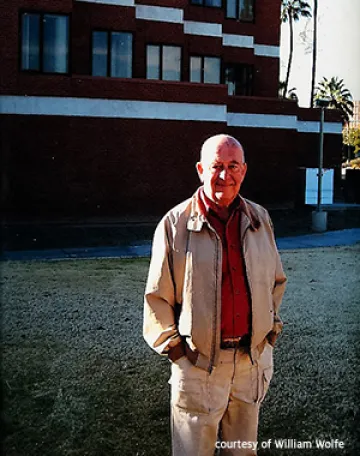Etendue: William L. Wolfe Jr.

Welcome to Etendue, featuring interesting and accomplished individuals known for their leadership and contributions both with their careers and the College of Optical Sciences, in their own words. (For a similar view on the college’s best and brightest – our students – please check out Another Wavelength among our Students in the Spotlight.)
This week, we hear from William L. Wolfe, Jr.
Where are you from?
I was born at a very early age in Yonkers, NY. I went to Bucknell University in Lewisburg, PA, and majored in physics. Then to the University of Michigan where I got my masters degrees in physics and electrical engineering, while working full time at the U of M Willow Run Labs. I avoided the draft in 1954 by going to Korea on a research project.
How did you get interested in optics?
When I returned I had the choice of joining any of several different labs, including radar, vision, acoustics and systems design. I chose the Infrared Lab because I had no idea about what it was, and it must be new and cutting edge. And that began my long association with optics.

Describe your career.
While at Michigan I was responsible for assisting the exchange of military infrared information among government and industrial organizations (while learning what it was). In 1966 I joined the Honeywell Radiation Center in Lexington, MA as chief engineer and manager of the Electro-optical Systems Department. I was responsible for the design of infrared viewing and targeting equipment for tanks and for infrared recon devices for aircraft, among other projects.
In 1969 I became Professor of Optical Sciences here at the College (then the Center). I found that to be my true calling, helping young people succeed and assisting companies and government agencies via consulting. A few of my favorite projects are: The Army Metrological Range, The Venus Probe, the Air Force Weather Sensor and the Cadillac Night Vision Device, although the many measurements of refractive indices of materials from 05 to 15 μm and 20K to 500K, and the measurements of scatter from 0.5 μm to 500 μm also rank high.
What are you doing now?
Since I retired I have written six books, two for non-technical readers, and presented lectures on topics in optics to retirees, fifth graders, college students and whoever will listen. I have sung to assisted living groups, occasionally finished a crossword puzzle and caught wily trout.
Why is staying in touch with OSC important to you and how are you involved?
I am truly grateful to the College for having provided me a rich living in every sense of the word. I want to see my old friends and pay back some of what I have received. I have endowed a scholarship and I preach and teach about the College every chance I get. It is important for the community to know what a fabulous institution this is.
[Editor’s note: The William L. Wolfe Family Graduate Student Endowed Scholarship is one of 30 FoTO (Friends of Tucson Optics) scholarships at the College. FoTO scholarships offer a perpetual award of $20,000 minimum to first-year Ph.D. students and their tuition is also waived.]
Name one neat fact about you.
I am blessed to be an octogenarian in good health who can remember all my students – and many of their quirks (Stace, Nof, Jim, Fred, Janet, Mary, Bob, Mitch, Kai, Lang, Yaujen...).

